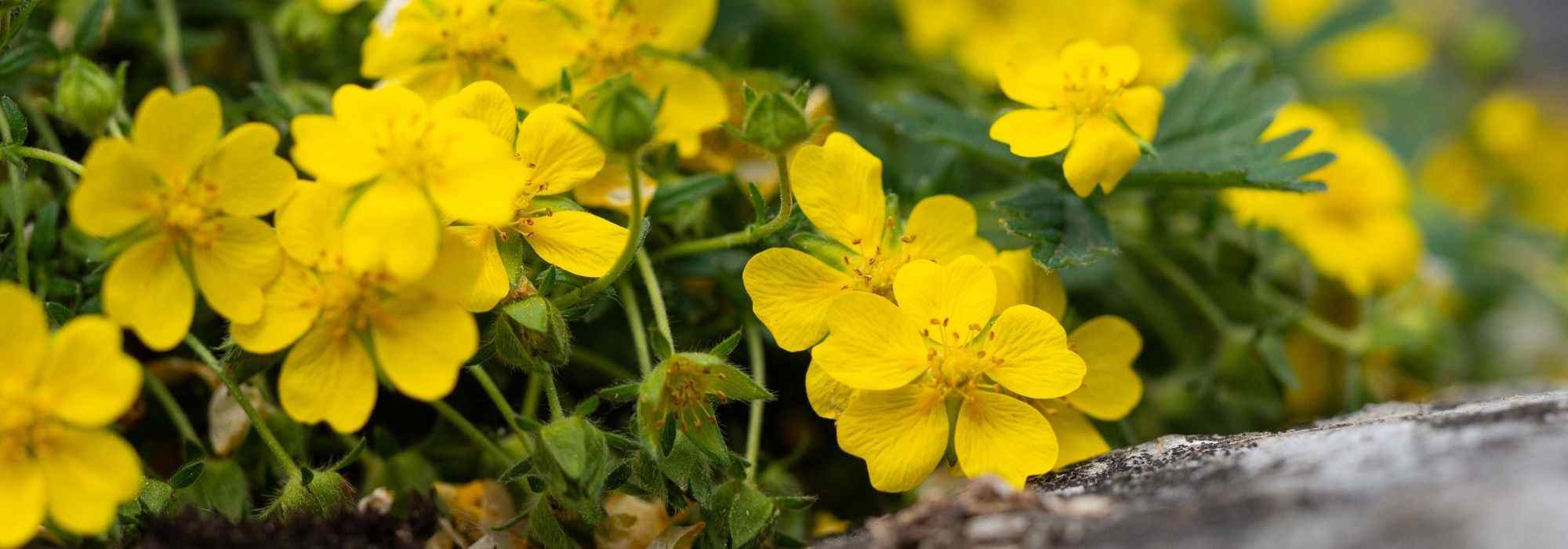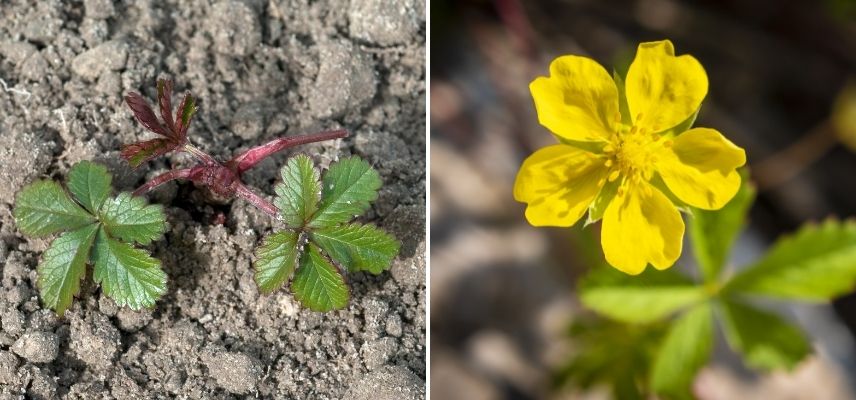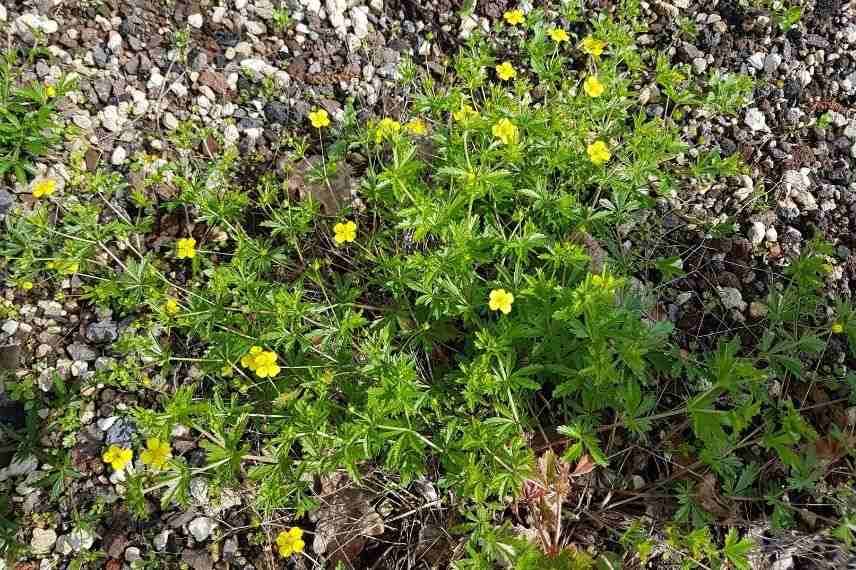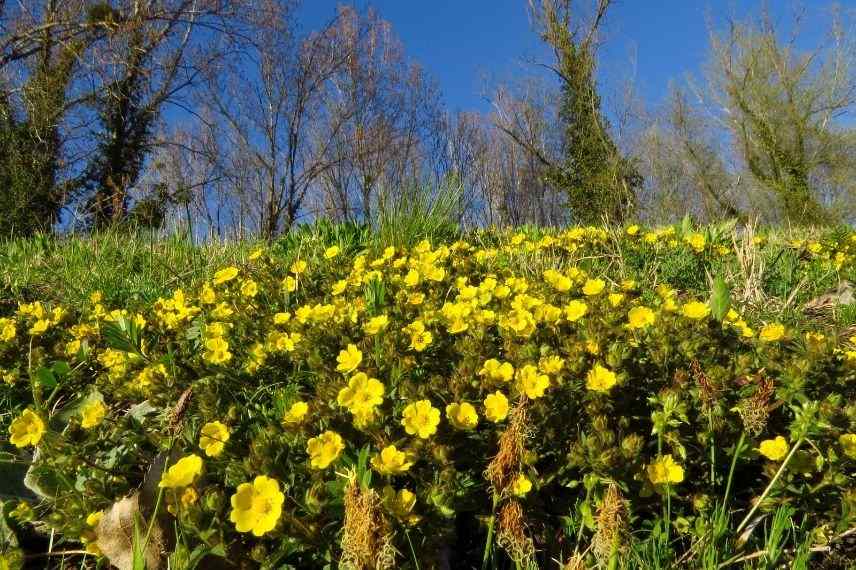
How to get rid of creeping cinquefoil?
Our tips for eradicating it naturally and effectively.
Contents
The creeping cinquefoil, like bindweed, couch grass, or creeping buttercup, is one of those plants considered by some gardeners as “bad” herbs or unloved adventives.
While their flowers do possess a certain rustic charm, it is mainly their tendency to become quickly invasive, even smothering nearby crops, that makes them undesirable in the garden.
Before launching a weeding operation, let’s see how to recognise creeping cinquefoil among other wild plants and identify the habitats conducive to its development.
We will then look at the tools needed to eliminate it and get rid of it without chemicals, as well as the natural techniques and tips to prevent its spread.
Identify the creeping cinquefoil
How to recognise it?
Creeping cinquefoil (Potentilla reptans) is a herbaceous plant belonging to the Rosaceae family (strawberries, roses, raspberries, cherries,…).
Within the Potentilla genus, we also find perennial cinquefoils and shrubby cinquefoils.
Creeping cinquefoil primarily originates from Europe and Asia. It is also known by the names five-finger, five-leaf herb, or Mars’ hand.
With a height of 10 to 20 cm, the plant is initially recognisable by its spreading and creeping habit.
Its short stems are covered in fine, short hairs (pubescent). The leaves have 5 obovate leaflets (widening at their tips) that are very dentate. This deciduous foliage disappears in autumn and reappears the following spring.
The spindle-shaped root penetrates deeply into the soil and produces runners that can reach up to 1 metre in length, allowing it to develop rapidly. The plant also self-seeds spontaneously, further enhancing its great colonisation ability.
From June to August, creeping cinquefoil reveals bright yellow flowers reminiscent of buttercups. Its 5 petals are, however, cordate (heart-shaped) and the flowers average 15 to 30 mm in size.
 Leaves and flower of Potentilla reptans
Leaves and flower of Potentilla reptans
What is its natural habitat?
Creeping cinquefoil is a wild plant found across much of the French territory, except at high altitudes.
Common in gardens, it prefers slightly moist environments, in sunny exposure, as well as soils that are generally rich in nitrogen, whether clayey or sandy.
It is often found in:
- gardens
- meadows
- path edges
- ditches
- gaps between rows in vegetable gardens
It is a pioneer plant, meaning it is among the first species to recolonise poor or unstable land.
It also has good adaptability, as it is hardy down to -15°C and fairly resistant to drought.
 Potentilla reptans in poor soil
Potentilla reptans in poor soil
Read also
Weeding... the natural way!Get rid of creeping cinquefoil naturally
To eliminate creeping cinquefoil, the most natural and effective method is deep manual weeding.
While this method may prove time-consuming and tedious depending on the size of the area to be weeded, it ultimately allows for the complete destruction of the plant, without the use of chemical and non-selective herbicides.
When to eliminate it?
The younger the plant, the easier it can be eliminated. Therefore, it is ideal to act as soon as the unwanted plant is spotted. Note that an area already containing other nearby crops will be more challenging to clear.
To proceed with the elimination of creeping cinquefoil, prefer:
- autumn, to weaken the plant which will not have time to build up reserves before the cold season;
- late winter, before the spring growth resumes.
Work in dry weather, but in moist and well-drained soil to facilitate the removal of all roots.
How to eliminate it?
To completely eliminate creeping cinquefoil, it is essential to use a tool to extract the long, fine, vertical roots of the plant, which are buried deep in the soil.
For this, use a weeding knife, a gouge, a dandelion weeder (ideal for heavy and compact soils) or a root puller.
- Using a digging fork or a broadfork, loosen the soil around the creeping cinquefoil, about twenty centimetres deep;
- Remove all aerial and underground parts of the plant (stems, leaves, roots, stolons, etc.);
- Extract the long vertical root(s) with the appropriate tool;
- Dispose of the vegetation at a waste facility and not in household compost, to avoid any risk of regrowth.
As with all “weeds” with stolons, avoid using a rotavator or spade, as they will only fragment the roots and allow for further propagation of the plant.
If the wild plant persists, you can opt for the solarisation solution: this covering technique deprives the plant of light and forces it to exhaust its energy reserves. For this, install an opaque and permeable cloth or a black tarp over the affected area for several months, until the creeping cinquefoil is destroyed.
 Weeding knife, gouge, dandelion weeder, and root puller
Weeding knife, gouge, dandelion weeder, and root puller
Combatting the presence or proliferation of Potentilla reptens
Several natural solutions can help prevent the appearance of creeping cinquefoil or at least contain its spread:
- grow ground cover plants, such as Bellecour ivy, and never leave bare soil in the garden;
- sow green manures (camelina, white mustard, buckwheat, alfalfa,…) which, in addition to taking the place of adventive plants, will naturally aerate the soil;
- rebalance the nitrogen level in the soil if it is too high, for example by growing nutrient-hungry plants like leafy vegetables (spinach, chard, lettuce, cabbage,…).
Mulching, which limits the development of some “weeds”, is not very effective against creeping cinquefoil, as its long roots allow it to draw nutrients from deep within the soil.

On the left: spinach; on the right: Bellecour ground cover ivy and camelina, which is a good green manure (photo naturguckert)
Read also
7 tools to weed easily and naturallyIs creeping cinquefoil such a bad herb?
Like most adventive plants, creeping cinquefoil also has its advantages.
It is a true bio-indicator: its presence provides information about the condition of a soil. Its development is indeed often the result of soil that is too nitrogen-rich, overly amended, trampled, compacted, or even asphyxiated.
From an aesthetic point of view, in a wild-looking garden or amidst short grass meadow, its small bright flowers can certainly add a touch of natural charm. They are also appreciated by our dear and essential pollinating insects.
Finally, it is an edible plant that can be used (under medical advice) for the astringent, anti-inflammatory, or even antipyretic properties of its leaves and roots.

Potentilla reptans creating a beautiful carpet of flowers
- Subscribe!
- Contents
































Comments